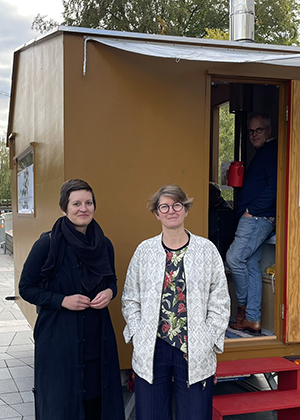Research: A tiny house on wheels inviting to think differently about householding with resources
2025-10-10
The project was about a tiny house on wheels that travelled around to different places, inviting people to rethink how we use everyday resources and how we live together.
 Inside this little house, things worked a bit differently. Instead of buying new things, the house encouraged using what’s already available – or even growing it. One experiment asked: Could a tiny house on wheels be dressed up for different seasons? Or Can we grow a window blind inside the house? Imagine planting barley on your kitchen floor, watering the plants carefully, and watching the grass grow. Later, you cut the grass, juice it, serve it to your neighbours and craft a window blind to keep the strong summer sun out.
Inside this little house, things worked a bit differently. Instead of buying new things, the house encouraged using what’s already available – or even growing it. One experiment asked: Could a tiny house on wheels be dressed up for different seasons? Or Can we grow a window blind inside the house? Imagine planting barley on your kitchen floor, watering the plants carefully, and watching the grass grow. Later, you cut the grass, juice it, serve it to your neighbours and craft a window blind to keep the strong summer sun out.
Learning anywhere
Instead of inviting people to a fixed workshop place, the Tiny House on Wheels visited people and communities in their environments and therefore became a tiny pop-up lab, exhibition space, or even an indoor ice-disco. It drove to neighbourhoods, conferences, fairs, and had a life of its own, accompanied by the project team and creating temporary spaces where people could gather, learn, and co-create.
– Being able to creatively and sometimes radically experiment with a building and stage an idea for real, is a very important learning experience that should be available in more environments. These playful and experienceable interventions invited people to think about how we use materials, how fast we expect things to be ready, and how we can design in correspondence with the seasons instead of controlling environments, explained Svenja Keune, researcher in design at the Swedish School of Textiles and subproject leader in seasonal experiments within the project.
Living with what is available and sharing it
The project also explored how households can work with what they already have, rather than always buying more. The idea of “surplus” means looking at what’s left over – time, materials, energy – and finding creative ways to share it. It’s a fresh take on budgeting, focused more on community and care than on cutting costs.
Final of the project – a book with reflections
One of the projects outcomes is a book about seasonal designing, with contributions from some of the many people the project has collaborated with or met along the way. The book was released in connections with the conference “Idéburet och social byggande” (in English Value-based and community-oriented development) at the Textile Fashion Center in Borås 2-3 October.
– The book showcases some of the seasonal interventions that have been setup during the years. “Usually, you don't consider the winter darkness, or freezing temperatures to be a resource for design, but if you do, a whole palette of opportunities opens up – and whatever you do automatically relates to some of the environmental challenges we need to address urgently. We do this in a creative and playful way, reflected Svenja Keune.
Designing with the seasons
– One of the most powerful lessons from the project was about seasonal design. Just like nature changes with the seasons, our homes and habits can, too, Svenja Keune said.
The team behind the tiny house encourages designers to think about time, place, and weather when creating things.
– It’s a way to stay connected to the world around us and respond to its rhythms, Svenja Keune concluded.
As a next step Svenja Keune now already plans to co-build the next architectural experiment.
Read more
The project Holding Surplus House ran over four years and ended in October 2025. It was funded by Formas - The Swedish Research Council for Environment, Agricultural Sciences and Spatial Planning.
The project was carried out by Åsa Ståhl, leading the project and the collaboration, Stephan Hruza, and Mathilda Tham, all three researchers from Linnaeus University, and Svenja Keune, researcher at the Swedish School of Textiles, University of Borås in collaboration with Växjö Art Gallery.
Read more about the project Holding Surplus Household (Linnaeus University webpage)
About the project at the University of Borås webpage
Read the book Seasonal Designing with the Holding Surplus House
Solveig Klug
Solveig Klug / Svenja Keune



